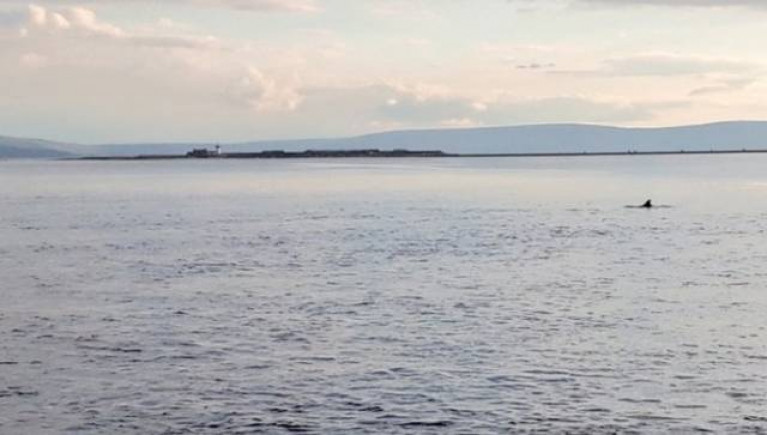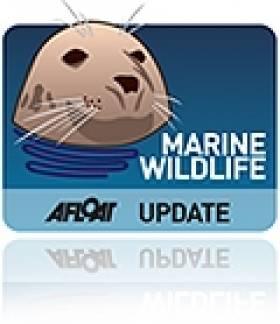Displaying items by tag: Bottlenose Dolphin
Ireland’s Newest Resident Dolphin Gets A Name
Ireland has a new resident dolphin, as a solitary bottlenose seems to have made its home in Carlingford Lough — and locals have voted to name it ‘Finn’.
Nearly 3,000 people took part in the Facebook poll in which Finn (the Anglicisation of Fionn) won out over ‘Bobby’ in a landslide.
“As we don't know if the dolphin is male or female, Finn works well as it is a popular name for both boys and girls,” the Carlingford Lough and the Cooley Peninsula Facebook page said.
“But if we can call our famous legend Finn or Fionn, we are sure the dolphin won’t mind.”
Carlingford dolphin this evening @CarlingfordIRE @DundalksNews pic.twitter.com/uW99G5EqE3
— peter noone (@peterno53001163) July 17, 2020
The Dundalk Democrat reports that Finn has been recently sighted ‘belly flopping’ near the port of Greenore — but marine wildlife experts warn that this may be a sign of distress.
Particularly in light of reports that a snorkeller was seen swimming close to the dolphin, all water users are to be reminded that it is a wild animal and advised to keep their distance.
Nimmo The Bottlenose Dolphin Heralds Spring In Galway City
The traditional first day of spring in Ireland also saw the return of Nimmo, a bottlenose dolphin who’s become a regular visitor to Galway city.
The Irish Whale and Dolphin Group (IWDG) says this is the sixth consecutive year for this particular dolphin, who has stayed for anywhere between four and eight months since 2016.
As reported this time last year on Afloat.ie, Nimmo’s predilection for Galway Harbour is a sign that the area has become an important feeding habitat.
“This is a wonderful opportunity for people in Galway to observe a wild dolphin close to a city centre and often within clear view of the shoreline,” says IWDG sightings officer Pádraig Whooley.
He also calls on local citizen scientists and marine wildlife watchers to submit their own sightings over the coming months.
A bottlenose dolphin was recently rescued by quick-thinking locals after live stranding on Mutton Island near Galway city.
The Irish Whale and Dolphin Group (IWDG) reports the story related to it by friend of the group Jason, who was alerted to the marine mammal in the shallow water near the Galway Bay lighthouse by an Australian couple with whom he had previously been discussing the area’s resident bottlenose Nimmo.
“I just knew it was in trouble so I ran down and the dolphin was out of the water alive,” he said.
With the tide going out, time was of the essence as Jason was joined by three others who offered their scarves to form a brace to lift the dolphin into deeper water.
“I just went the rest of the way as it was getting dark at that point. With one final push it just started to swim away.
“I can’t explain how I felt and we did it as a team. An incredible thank you so so much to those who helped,” he added.
The incident came just days after the IWDG called on the Government to join forces with NGOs like itself to develop a stranding response protocol, especially for large whales.
The IWDG said “fresh attention” has been drawn to the issue following the death of a fin whale seen swimming in Dublin Port earlier this month.
More recently, an endangered sei whale was found floating in the River Thames at Gravesend in the UK last Friday (18 October), nearly two weeks after a humpback whale died in the same stretch of water.
IWDG chief executive Dr Simon Berrow said: “Strandings, both live and dead, of large whales are not common in Ireland but do occur and we need a protocol, signed off by relevant partners, including Government agencies, so we can respond quickly and efficiently in such cases without having to phone around looking for resources and support.”
Galway’s Dolphin Nimmo Returns To City Waters
#MarineWildlife - Galway residents have a great opportunity to see a wild dolphin close to the city centre with the return of regular visitor to the Nimmo’s Pier area this week.
Nicknamed Nimmo, the solitary bottlenose dolphin was first sighted in the city in April 2015 and since then has become an annual fixture, appearing and staying longer each time.
The Irish Whale and Dolphin Group (IWDG) suggests this is a sign that the area around Galway city is now a “more important core feeding habitat for Nimmo”.
In other news, the IWDG’s research vessel Celtic Mist will embark on a series of week-long surveys this summer in search of humpback whales.
IWDG members are invited to join any of the nine legs, the first of which sets sail from 9-15 June (weather permitting) between Cork and Dingle/Fenit.
For details on how to book a place on any of these voyages and for further information, contact [email protected].
Bottlenose Dolphins Seen Off Dublin For First Time In Over Three Years
#MarineWildlife - Marine wildlife fans in the Dublin Bay area will be on the lookout for a group of bottlenose dolphins that have been spotted between Killiney and Dun Laoghaire.
It's the first sighting of the species off South Dublin since August 2012 when a pod of three dolphins that had delighted local residents for two years, as previously reported on Afloat.ie, moved on around the coast towards Kerry and beyond.
According to Irish Whale and Dolphin Group sightings officer Pádraig Whooley, it's not clear whether this is the same group of two adults and a juvenile returning to their previously regular haunt.
But with regular reports of sightings between Scotsman's Bay, Bullock Harbour and Killiney Bay since 2 January, there will surely be plenty of opportunity to get the necessary photographic evidence.
Dolphin Visitor 'Clet' Pops Up In Scotland
#MarineWildlife - Two months after striking up a friendship with fellow 'dolphina-non-grata' Dusty in his travels around Ireland, 'bad boy' bottlenose Clet has moved on again - this time to the west coast of Scotland.
According to the Island News & Advertiser, Clet appeared in the Sound of Mull in the Inner Hebrides during the week - his first confirmed sighting after he was seen frolicking with Dusty in Galway Bay - making for a rare sighting of a solitary dolphin in the area.
“To our knowledge, this is the first time that Clet has been recorded in Scotland, and in fact this is the furthest north he has been recorded to date,” said Dr Conor Ryan, sightings officer with the Hebridean Whale and Dolphin Trust.
Pádraig Whooley of the Irish Whale and Dolphin Group (IWDG) also hailed Clet's reappearance, saying: "The addition of Scotland after a two-month interval brings his known tally of passport stamps to five countries and counting, and shows the need for international collaboration when trying to monitor these highly mobile marine mammals.”
But Scottish dolphin-watchers be warned, as Clet may have been involved in an act of aggression towards swimmers near Galway city in early October.
The Island News & Advertiser has more on the story HERE.
Dolphin Group Celebrates Ireland's First Refloating Success
#MARINE WILDLIFE - A stranded dolphin has been successfully refloated for the first time ever in Ireland thanks to the efforts of volunteers with the Irish Whale and Dolphin Group (IWDG).
As the Irish Examiner reports, the group was alerted by a woman who saw the 3.5-metre bottlenose dolphin on a beach at Béal on the Shannon Estuary in north Kerry on 1 June.
Volunteers on the scene discovered the female dolphin's skin was still moist, which indicated it had only recently stranded.
After checking for injuries, the team decided not to wait for special whale pontoons to arrive from Kilrush and instead used a local farmer's tractor and low loader to lift the dolphin out of the sand.
The dolphin was slowly moved back to the water, where she was stabilised before she regained composure and was able to swim away.
Images of the dolphin's dorsal fin were captured by the volunteers for the IWDG's records, which enabled researchers to confirm subsequent sightings among a pod of some 140 dolphins swimming in the estuary - with the latest spotting on 27 June on a dolphin-watching boat trip, where she appeared to be in good health.
In a statement, the IWDG said: "The loss of one dolphin, especially an adult female, could have a significant impact on this population, thus highlighting the importance of the prompt action on the shore at Béal."




























